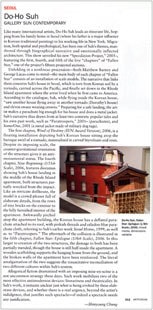
SEOUL
Do-Ho Suh
GALLERY SUN CONTEMPORARY
By Shinyoung Chung
Like many international artists, Do-Ho Suh leads an itinerant life, hopping from his family home in Seoul (where his father is a major influence I in Korean traditional painting) to his working life in New York. Migration, both spatial and psychological, has been one of Suh's themes, manifested through biographical narrative and emotionally inflected architecture. This show unveiled his new "Speculation Project," 2005-, featuring the first, fourth, and fifth of the five "chapters" of "Fallen Star," one of the project's fifteen projected sections.
Unfolding in a nonlinear procession-both Matthew Barney and George Lucas come to mind-the main body of each chapter of "Fallen Star" consists of an installation of scale models. The narrative that links them concerns Suh's house in Seoul, which is torn from Korean soil by a tornado, carried across the Pacific, and finally set down in the Rhode Island apartment where the artist lived when he first came to America. According to the catalogue, Suh, while flying inside the Korean house, "saw another house flying away in another tornado (Dorothy's house) and eleven swans wearing crowns." Preparing for a safe landing, the artist makes a parachute big enough for his house and dons a metal jacket. Suh's narrative thus draws from at least two contexts: popular tales and his own past work, such as "Paratroopers," 2001- (parachutes), and Some/One, 2001 (a metal jacket made of military dog tags).
The first chapter, Wind of Destiny (SUN Award Version), 2006, is a floating installation depicting Suh's Korean house sitting atop the baroque swirl of a tornado, materialized in carved Styrofoam and resin. Despite its imposing scale, the counter-gravitational orientation of the structure gives it an anti-monumental status. The fourth chapter, New Beginning (1/35th Scale), 2006, features dioramas
showing Suh's house landing in the middle of the Rhode Island apartment, both structures partially wrecked from the impact. Like an intricate dollhouse, the model is a crowd-pleaser full of elaborate details,from the rows of tiny bricks on the exterior to the fully furnished interior of the apartment. Awkwardly pitched atop the apartment building, the Korean house has a deflated parachute attached to its roof, with pinkish threads and celadon-blue parachute cloth, referring to Suh's earlier work Seoul Home, 1999, as well as to "Paratroopers." The aftermath of the collision is illustrated in the fifth chapter, Fallen Star: Epilogue (1/8th Scale), 2006. In this larger re-creation of the two structures, the damage to both has been partially mended, though the house is still half inside the apartment. A wooden scaffolding supports the hanging house from the ground, and the broken walls of the apartment have been reinforced. The literal amalgamation of the two suggests the resuscitative reconciliation of two different cultures within Suh's system.
Allegorical fiction dramatized with an imposing mise-en-scene is a not uncommon strategy these days. Such work mobilizes two of the most effective antimodernist devices: literariness and theatricality. In Suh's work, it remains unclear just what is being evoked by these elaborate devices, and whether there is a real urgency, beyond the artist's indulgence, that justifies such spectacle--if indeed a spectacle needs any justification.
-Shinyoung Chung
